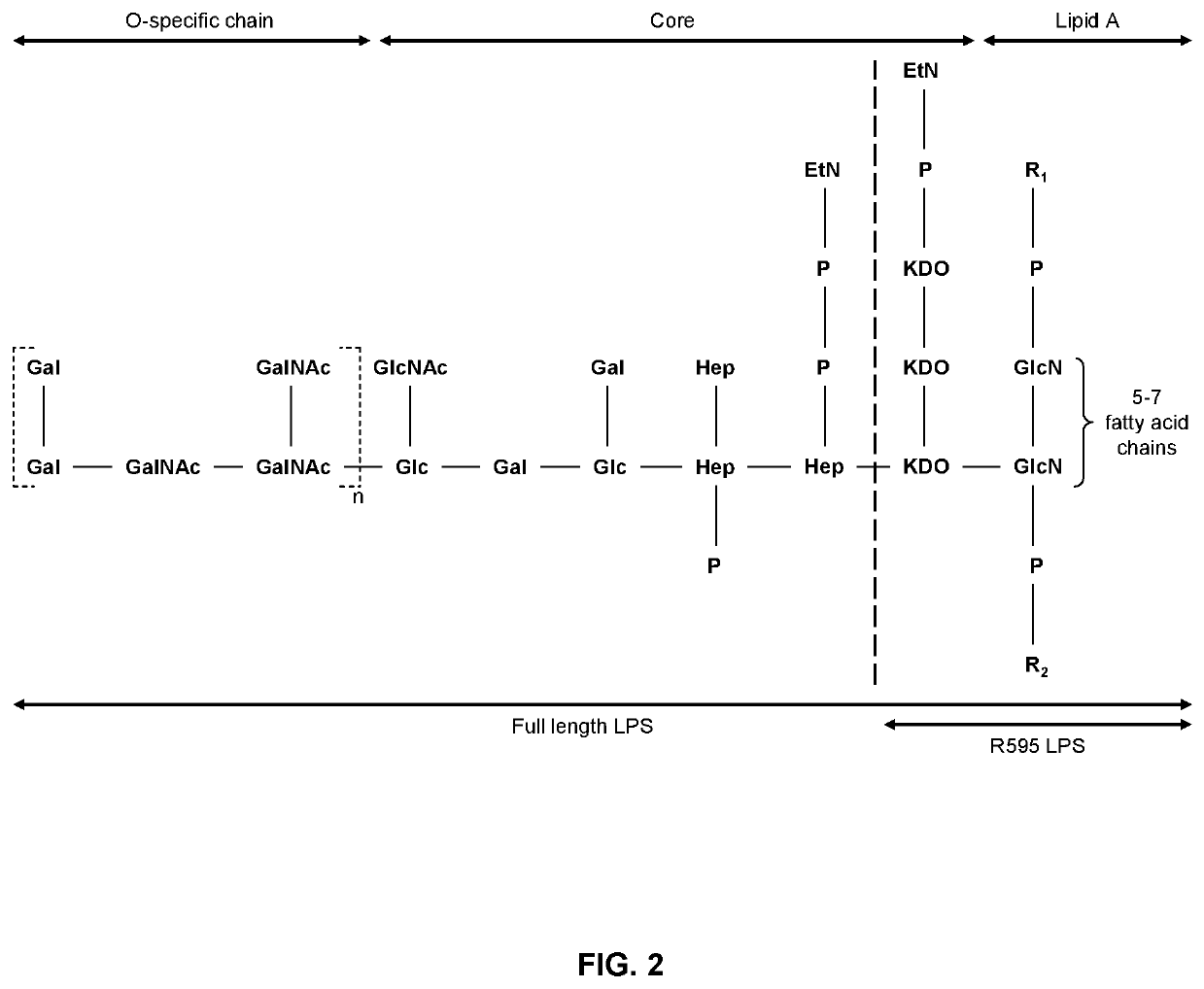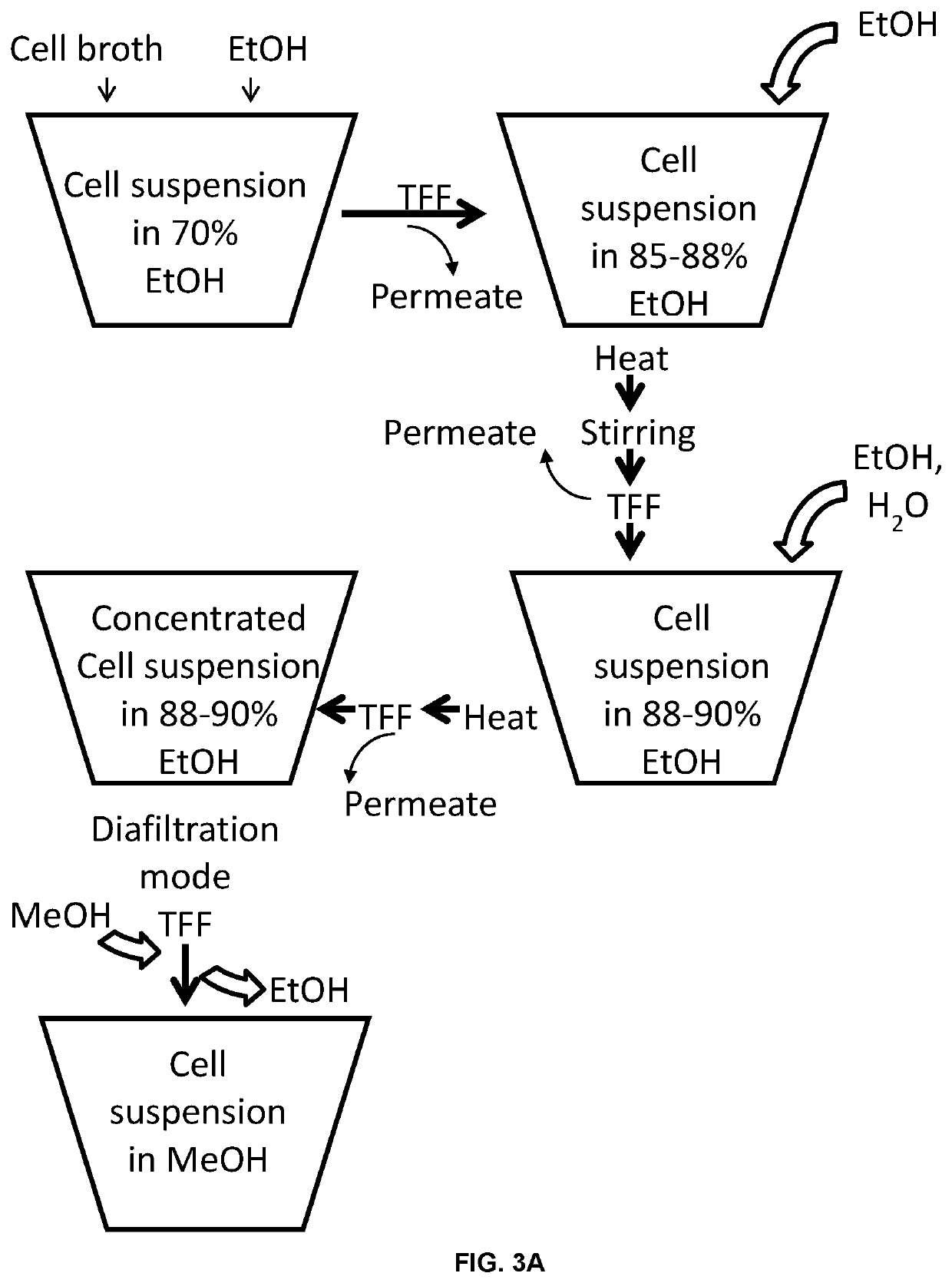Lps extraction process
- Summary
- Abstract
- Description
- Claims
- Application Information
AI Technical Summary
Benefits of technology
Problems solved by technology
Method used
Image
Examples
example 1
tion of Increased Extraction of LPS with Salt Addition—at Bench Scale
[0085]One liter of fermentation broth from a batch fermentation of S. minnesota R595 is centrifuged in four 250 mL centrifuge bottles. Two rinses with purified water are then performed as follows: the pellets are resuspended in 200 mL purified water, pooled into a single centrifuge bottle, centrifuged, supernatant discarded, resuspended in 200 mL purified water, centrifuged, and supernatant discarded.
[0086]Two ethanol extractions are performed to remove phospholipid impurities: The cells are resuspended in 60 mL of 95% reagent alcohol (+5% water) and then stirred in an incubator at 50° C. for 45 minutes. The cells are then centrifuged and the supernatant is discarded. The cells are resuspended in 60 mL of 90% reagent alcohol (+10% water) and then stirred in an incubator at 50° C. for 45 minutes. The cells are then centrifuged and the supernatant is discarded. The cells are then rinsed twice with 100 mL of methanol ...
example 2
n with Ethanol to Remove Phospholipid Impurities—at a Production Scale
[0090]Cell broth+EtOH in Extraction vessel→filtration (TFF) with ceramic membrane→Retentate (=cell suspension in ˜70% ethanol)
[0091]Retentate+EtOH→heat→stirring→concentration by TFF→Retentate (=cell suspension in 85-88% EtOH)
[0092]Retentate+EtOH+H2O+heat→concentration by TFF→Retentate (=cell suspension in 88-90% EtOH)
[0093]Retentate→EtOH replaced by MeOH under diafiltration mode of TFF→Retentate (=cell suspension in MeOH)
[0094]Approximately 34 L of concentrated S. minnesota R595 cells containing approximately 1600 grams dry cell mass (harvested from a batch fermentation, where tangential flow filtration was used to concentrate and diafiltrate the cells with purified water), and 77 L of reagent alcohol, are charged into a 200 L jacketed stainless steel vessel with agitator and temperature control. This mixture is then concentrated to 36 L with a Tangential Flow Filtration (TFF) unit, fitted with a 19 channel cylind...
example 3
n of LPS without Salt Addition—at a Production Scale
[0099]Retentate+CHCl3+heat→concentration by TFF→Permeate (=Chloroform-Methanol Extract (CME)) in collection vessel.
[0100]Following the washes with ethanol and methanol rinses as described in Example 2, 50 L of CHCl3 is added to the retentate. To extract the LPS, the mixture is next heated at 50° C. for 16 hours. The mixture is then concentrated by TFF to approximately 13 L, with permeate being directed to a stainless steel collection vessel. Chloroform (20 L) and methanol (8 L) are added to the retentate and the mixture is again concentrated to approximately 13 L, with permeate being directed to the collection vessel.
[0101]The collected permeate is concentrated in a 50 L Buchi R-250EX rotary evaporator to approximately one liter. This volume is transferred into two 2 L round-bottom flasks (using additional chloroform to rinse and complete the transfer). The solvent evaporation is then completed using a Buchi R-215 rotary evaporator...
PUM
| Property | Measurement | Unit |
|---|---|---|
| Fraction | aaaaa | aaaaa |
| Fraction | aaaaa | aaaaa |
| Fraction | aaaaa | aaaaa |
Abstract
Description
Claims
Application Information
 Login to View More
Login to View More - R&D
- Intellectual Property
- Life Sciences
- Materials
- Tech Scout
- Unparalleled Data Quality
- Higher Quality Content
- 60% Fewer Hallucinations
Browse by: Latest US Patents, China's latest patents, Technical Efficacy Thesaurus, Application Domain, Technology Topic, Popular Technical Reports.
© 2025 PatSnap. All rights reserved.Legal|Privacy policy|Modern Slavery Act Transparency Statement|Sitemap|About US| Contact US: help@patsnap.com



